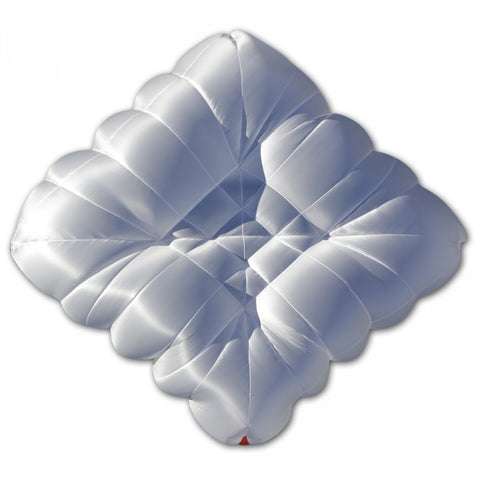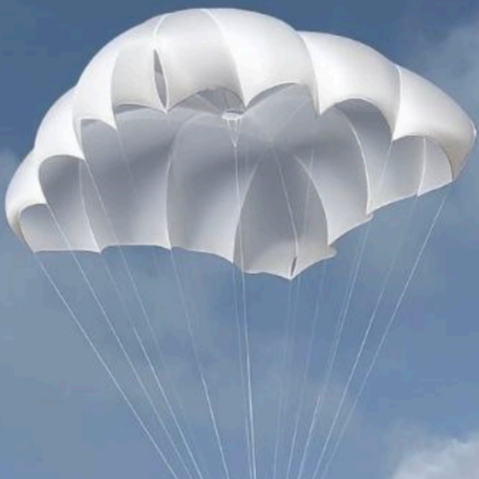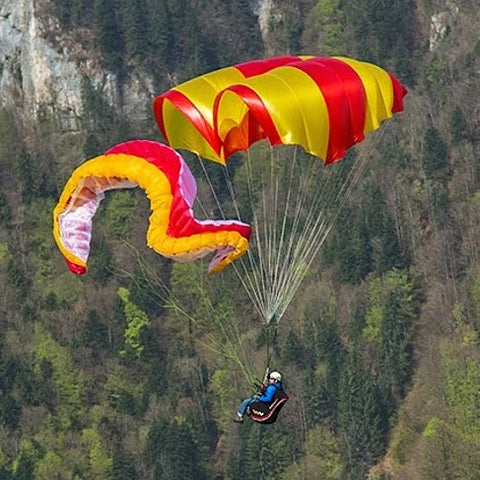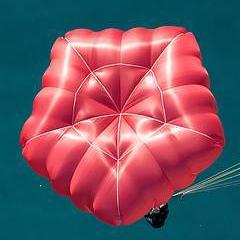
Charly DIAMOND Cross Light Basic (Non-Steerable Square)
Charly DIAMONDcross Light Basic (None Steerable Version) is a super light none steerable square reserve
Packing Instructions
Charly DIAMOND Cross - the reserve parachute for every situation
https://charly-produkte.de/dcinfo-en.pdf (More details about below topics)
When choosing your emergency reserve parachute, there are many parameters which you should pay attention to in advance. One thing, however, is never predictable: When, where and if you ever need to use your parachute.
Steerable vs. non-steerable rescue systems
The canopy trim with S-fold, similar to hang gliders, provides a high righting moment. The risk of downplane and stable shear positions are thus prevented.
Disconnecting vs. not disconnecting the main glider
In any case, the canopy trim ensures that the main glider can be easily pulled in with little effort, or even at least unilaterally be released with conventional carabiners, also if it is not disconnected.
Parachutes with headway vs. vertical sinking
Due to the diagonal orientation of the canopy and the trim with longer lines at the trailing edge, the Charly DIAMOND Cross generates a high aerodynamic righting moment. Therefore, there is no tendency for a stable downplane as it is the case for Rogallos with similar forward speed.
New tests performed for opening safety of the DIAMOND Cross
Author and test pilot: Tom Grabner
Already during the development of the DIAMONDcross, the topic "entanglement of the rescue system with the main glider" was crucial for diverse product details, which have been certified with additional tests far above certification criteria during the summer. The most dangerous situations for a rescue system becoming entangled with the main glider are SAT-like rotations after tangling up. This was simulated by holding collapses.
- Charly DIAMONDcross steerable rescue parachute: Deployment in SAT-like rotations (left) https://youtu.be/EEmj4LcDkms
- Charly DIAMONDcross steerable rescue parachute: Deployment in SAT-like rotations (right) https://youtu.be/IIyT2XU4_DE
DIAMOND Cross has a defined forward speed in a diagonal direction with the effect of a significantly reduced sink speed. This results on the one hand in a higher aspect ratio compared to conventional square canopies, those propulsion mainly takes place towards one side, and on the other hand in the asymmetrical airflow of the convex sides of the DIAMONDcross canopy, thereby receiving an ascending forced optimised profile.
The horizontal movement which is typical for every modern round canopy and square canopy can be steered for the DIAMONDcross ST in a certain direction if required. Obstacles like e.g. power lines can thus be avoided and an emergency landing field can be precisely approached with a glide ratio of ca. 1:1,5. There are no disadvantages for the DIAMONDcross ST compared with conventional cruciform canopies.
The DIAMOND Cross has different line lengths which have the effect that the strips of the canopy don't lie on top of each other when packing the canopy. This diversification causes an easier air inlet when opening and thus an increased opening speed compared to conventional square canopies. The packing of the DIAMONDcross is not more time-consuming or more complex than for a normal cruciform canopy.
The superlight DC thus combines the low packing effort of round- and square canopies. For the DIAMONDcross, there is no risk of „downplane" directly after opening, which is the case for Rogallo rescue systems, also when flown too slow, if it opens with the top downwards.
Further Safety Aspects

The long suspension lines of the DIAMONDcross and the symmetric shape of the canopy lower the risk of causing a collapse of the rescue system and the glider.
The special design of the inner container, optimised with the help of Tom Grabner's G-Force trainer ensures safe deployment of the DIAMONDcross with the low effort needed. Especially with regard to inconvenient pulling directions when deploying the rescue system. Therefore we absolutely recommend to use the original approved container with the rescue system and to adapt the rescue handle of the harness to the container by an authorised service company.
The inner container has a separate space for the suspension lines.
The canopy will only be deployed after the aspect ratio of the suspension lines, which enables a fast and controlled opening. The risk of a cravat of the rescue system and the glider is therefore reduced.
Q: Do I have to disconnect my glider when opening the DIAMONDcross?
A: No

Although if the pilot reacts in a passive way, the DIAMONDcross works perfectly. The risk of a side slip is very low for a DIAMOND Cross . Nevertheless, the glider should be disconnected – if possible – from all rescue systems, no matter whether they are steerable or not. The disconnection can be made by separating the glider from the carabiner, as in this case, an automatic separation system for speed system is absolutely essential. Further opportunities are quick-out carabiners or cutting off the main lines by means of a hook knife. With the Charley Quick-Out carabiners, the disconnection is very simple. As you can't make general statements about how the glider reacts after rescue deployment and every rescue system is always influenced by the residual resistance of the glider, complete disconnection of the glider can only be an advantage – also if a disconnection is not absolutely necessary for the DIAMONDcross.
Technical Data

We Also Recommend





